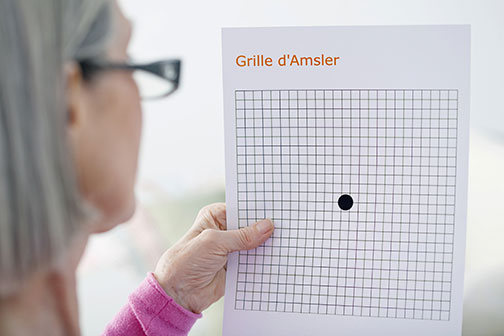What is Macular Degeneration?
 Macular degeneration or age-related macular degeneration (AMD) is the most common cause of vision loss in people over the age of 65. In its more advanced stages, AMD will cause patients to have a very noticeable decrease in their ability to see sharply, or use focused vision, which is the type of vision required for reading or watching television. For about 90 out of every 100 patients with AMD, this loss of vision is a very gradual process. Patients who show this gradual vision decrease have what is often called the dry form of AMD. However, for the remaining 10% of patients who are diagnosed with the wet form of AMD, there can be a very rapid and dramatic loss of vision.
Macular degeneration or age-related macular degeneration (AMD) is the most common cause of vision loss in people over the age of 65. In its more advanced stages, AMD will cause patients to have a very noticeable decrease in their ability to see sharply, or use focused vision, which is the type of vision required for reading or watching television. For about 90 out of every 100 patients with AMD, this loss of vision is a very gradual process. Patients who show this gradual vision decrease have what is often called the dry form of AMD. However, for the remaining 10% of patients who are diagnosed with the wet form of AMD, there can be a very rapid and dramatic loss of vision.
A person with dry AMD may gradually lose detailed vision as light-sensitive cells in the retina slowly break down over time. AMD usually affects both eyes, but it can begin by affecting only one eye initially.
Dry and Wet Age Related Macular Degeneration
In dry AMD, changes called drusen, develop in the pigment layer of the macula. At first the drusen are small and few in number, and vision is not affected. With time, more drusen, larger drusen, and other pigment changes may develop along with a decrease in central vision. As a result, reading may become more difficult. At a later stage in some patients, parts of the pigment layer disappear entirely, and central vision is then lost, so that these patients can no longer read or drive.
Scientific studies that people with certain types of drusen and other pigment changes are at a higher risk of having their dry AMD change to wet AMD with a rapid and severe loss of central vision. People who have these changes in one eye and wet AMD in the other eye are at especially high risk.
The specific cause of wet AMD is the growth of new, abnormal blood vessels immediately under the retina, which is a lining in the back of the eye. This condition is known as choroidal neovascularization, or CNV. As these abnormal blood vessels grow under the retina, they leak and bleed. This causes damage to the macula, which is the portion of the retina that is responsible for sharp or focused vision.
AMD generally occurs in people who are 50 years or older, and the risk of developing AMD increases as a person gets older. In addition to age, other possible risk factors for AMD include the following:
- Gender: Women may be at greater risk than men, according to some studies.
- Smoking: Smoking may increase the risk of getting AMD.
- Family history: People with a family history of AMD may be at higher risk of getting the disease.
- Cholesterol: People with elevated levels of blood cholesterol may be at higher risk for developing wet AMD.
Macular Degeneration Treatments
Laser photocoagulation treatment is one option for the treatment of AMD. This treatment involves using a very powerful beam of laser light that is aimed at the area of new blood vessel growth. This laser light beam is powerful enough to cause permanent damage to the new blood vessels within the area being treated, but it can also cause permanent damage to the retina.
Another option for the management of wet AMD is photodynamic therapy (PDT) with Visudyne. In Visudyne photodynamic therapy, patients receive an injection (generally through a vein in their arm) of the light-sensitive drug Visudyne, which travels through the blood vessels in the body and accumulates in the abnormal blood vessels, in the eye. A special laser is then used to light up or activate the drug in the blood vessels of the eye. The activated drug then causes damage to the blood vessels and tissue very close to the activated drug without causing damage to the retina. In this way, the light-sensitive drug works only when deliberately activated by the special laser. PDT, however, is not approved for all AMD patients.
Alternatively, it may be possible to surgically remove the abnormal blood vessels. The surgical procedure, however, is not yet proven and has significant risks. Additionally, some investigators are testing radiation treatment, other light-activated compounds, and various other drugs for the treatment of AMD. As of now, no treatment has been shown to work in all cases of AMD. In many cases, patients prefer to have no treatment and allow a natural scar to form.
